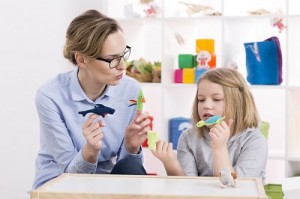So Your Child Needs Play Therapy. What’s Next?
 By Emily Cannon, MSW, LCSW, RPT
By Emily Cannon, MSW, LCSW, RPT
Through play therapy, children learn to express their feelings, modify their behavior, develop problem-solving skills and learn a variety of ways to relate to others. In part one of this blog, we covered what play therapy is, what types of challenges it can help your child overcome and how it works. Part two of this blog post helps to demystify the overall process for those who have decided play therapy might be worth trying.
Family Involvement
Though play therapy is intended for your child, the whole family should be involved and supportive. Prior to meeting with a child, a play therapist sits down with parents to gain family and developmental history. This “intake” helps the play therapist understand the presenting issue, learn more about family dynamics and formulate a plan for treatment.
If you have not experienced therapy or counseling before, this world might be foreign to you. You may have reservations about your child being in therapy, or doubts about its effectiveness. Talk to your child’s therapist about how you are feeling so you can be prepared to be 100 percent supportive.
Positive Approach
When it comes time to introduce your child to the idea of play therapy, take a positive approach and keep it simple. Never frame therapy as though it is a punishment for your child’s behavior, and never use going to therapy as a threat to illicit improved behavior.
Demystify mental health by correlating it with traditional health care. You can say something like, “You know how we go see Dr. Smith when your throat hurts or your tummy is really upset? Well, I met a nice lady and she is kind of like Dr. Smith. She is like a doctor but for feelings.” For younger children, a simple, “I thought it would be nice for you to have a grown-up friend who can have special play time with just you.” For a child, realizing that they can have an adult’s full, undivided attention is very powerful.
Generate Excitement to Lessen Anxiety
Most play therapists have pictures of their playrooms on their website. Sometimes showing a child those images prior to a session can help lessen anxiety. When I meet with parents for an intake they usually comment on something in the playroom they know their child will be drawn to or something they also have at home. I encourage them to let their child know about those toys; sometimes it even creates excitement.
Once your child starts seeing the therapist, the first phase of play therapy is aimed at developing a safe and trusting relationship between the child and therapist. Play can be very surface level during this time. Once children have built therapeutic rapport with their therapist, themes generally develop in play revealing what is going on in a child’s inner world.
While most kids look forward to coming to their play sessions, it is emotional work and change is being created. There can be some push back. Just like many things in life, you can’t go around it, you have to go through it. I always warn parents that they may see an increase in some of the behaviors that brought them into therapy for a period of time, but it is part of the child’s way of working through it.
In addition to the clinical work with the child, a play therapist also works very closely with parents throughout the process to help them gain insight into their child’s behavior and add tools to their toolbox to best support their child when he or she is at home or school.
Graduation!
The last phase of play therapy is graduation. This occurs when the parents, child and therapist feel confident that the gains made through the play therapy process are maintainable without regular sessions. It is common for children to sometimes come in for “check-up” sessions to review certain skills, or on an as-needed basis if other issues arise.
Emily Cannon is a licensed clinical social worker and has been working with children and families since 2007. Emily opened Pathways to Growth Counseling in 2012, with the goal of providing comprehensive services to individuals and families in and around Charlotte.
This blog was produced in partnership with Charlotte Parent. Click here for the original post and other parenting resources.













